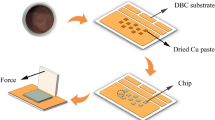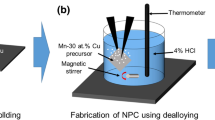Abstract
With the rapid development of the third-generation semiconductor materials, an appropriate high-temperature-resistant die attach material has become one of the bottlenecks to fully exploit the excellent properties of the third-generation semiconductor power devices. At the same time, a low-bonding temperature is always the pursuit goal of packaging engineers to reduce the thermal residual stress in electronic devices. In this paper, a low-temperature bonding method was proposed to address the above-mentioned issue based on In infiltrating the nanoporous Cu. In, as a low melting point metal, can significantly reduce the bonding temperature, and the nanoporous Cu structure can provide a very large specific surface area, which greatly increases the consumption rate of In. Furthermore, the formed Cu-In IMCs with high-remelting temperature can withstand the high operating temperature. The microstructures of the bondlines before and after bonding were studied in detail. The results show that the bondline can completely consume the low melting point In, within 10 min at 165 °C under a pressure of 0.75 MPa. When the bonding temperature was further increased to 310 °C, the bondline was composed of η-Cu2In and δ-Cu7In3 phases, whose melting points were more than 600 °C. The average electrical resistivity was determined to be 5.53 ± 0.65 μΩ cm, and the thermal conductivities were 144.33 W m−1 K−1, 139.24 W m−1 K−1 and 129.79 W m−1 K−1 at 30 °C, 150 °C and 300 °C, respectively. The average shear strength were 19.09 ± 3.4 MPa, 20.47 ± 4.6 MPa and 30.73 ± 5.2 MPa at 30 °C, 250 °C, 310 °C, respectively. These results indicate that the nanoporous Cu infiltrated with In could meet the requirements of electrical, thermal conduction, and mechanical support as a die attachment for high-power devices.










Similar content being viewed by others
References
A.Q. Huang, Power semiconductor devices for smart grid and renewable energy systems. Proc. IEEE 105, 2019 (2017)
A.A. Bajwa, Y. Qin, R. Reiner, R. Quay, J. Wilde, Assembly and packaging technologies for high-temperature and high-power GaN devices. IEEE Trans. Compon. Packag. Manuf. Technol. 5, 1402 (2015)
H.K. Shao, A.P. Wu, Y.D. Bao, Y. Zhao, G.S. Zou, L. Liu, Novel transient liquid phase bonding for high-temperature automotive power electronics systems. Mater. Sci. Eng. A 724, 231 (2018)
V. Talesara, P.D. Garman, J.L. Lee, W. Lu, Thermal management of high-power switching transistors using thick CVD-grown graphene nanomaterial. IEEE Trans. Power Electron. 35, 578 (2020)
J. Hornberger, A. Lostetter, K. Olejniczak, T. McNutt, S.M. Lal, A. Mantooth, Silicon-Carbide (SiC) semiconductor power electronics for extreme high-temperature environments. Aerosp. Conf Big Sky. 6–13, 2538–2555 (2004)
H. Greve, S.A. Moeini, P. McCluskey, S. Joshi, Prediction and mitigation of vertical cracking in high-temperature transient liquid phase sintered joints by thermomechanical simulation. J. Electron Packag. 140, 020903 (2018)
H.W. Zhang, J. Minter, N.C. Lee, A brief review on high-temperature, Pb-free die-attach materials. J. Electron. Mater. 48, 201 (2019)
L. Bernstein, Semiconductor joining by the solid-liquid-interdiffusion (SLID) process. J. Electrochem. Soc. 113, 1282 (1967)
L. Sun, M.H. Chen, L. Zhang, Microstructure evolution and grain orientation of IMC in Cu-Sn TLP bonding solder joints. J. Alloy. Compd. 786, 677 (2019)
S.W. Yoon, M.D. Glover, K. Shiozaki, Nickel-Tin transient liquid phase bonding toward high-temperature operational power electronics in electrified vehicles. IEEE Trans. Power Electron. 28, 2448 (2013)
W. Liu, Y.H. Mei, Y.J. Xie, M.Y. Wang, X. Li, G.Q. Lu, Design and characterizations of a planar multichip half-bridge power module by pressureless sintering of nanosilver paste. IEEE J. Emerg. Select. Topics Power Electr 7, 1627 (2019)
S.B. Wang, C. Kirchlechner, L. Keer, G. Dehm, Y. Yao, Interfacial fracture toughness of sintered hybrid silver interconnects. J. Mater. Sci. 55, 2891 (2019)
H. Zhang, Y. Liu, L.G. Wang, F.L. Sun, J.J. Fan, M.D. Placette, X.J. Fan, G.Q. Zhang, Effects of sintering pressure on the densification and mechanical properties of nanosilver double-side sintered power module. IEEE Trans. Compon. Packag. Manuf. Technol 9, 963 (2019)
W.H. Lin, C.H. Tsou, F.Y. Ouyang, Electrochemical migration of nano-sized Ag interconnects under deionized water and Cl-containing electrolyte. J. Mater. Sci.: Mater. Electron. 29, 18331 (2018)
J.D. Liu, H.T. Chen, H.J. Ji, M.Y. Li, Highly conductive Cu-Cu joint formation by low-temperature sintering of formic acid-treated Cu nanoparticles. ACS Appl. Mater. Interfaces. 8, 33289 (2016)
C. Domínguez-Ríos, M.V. Moreno, R. Torres-Sanchez, W. Antúnez, A. Aguilar-Elguézabal, Effect of tarteate salt concentration on the morphological characteristics and composition of Cu-Zn electroless plating on zamak 5 zinc alloy. Surf. Coat. Technol. 202, 4848 (2008)
C. Kadiri, A. Harbrabi, F. Bouzerara, Preparation and properties of tubular macroporous ceramic membrane supports based on natural quartz sand and dolomite. J. Aust. Ceram. Soc. 56, 379 (2020)
Q.F. Gao, M. Jrad, M. Hattab, J.M. Fleureau, Pore Morphology, porosity, and pore size distribution in Kaolinitic remoled clay under triaxial loading. Am. Soc. Civil. Eng. 20, 057 (2020)
Y.S. Chiu, H.Y. Yu, H.T. Hung, Y.W. Wang, C.R. Kao, Phase formation and microstructure evolution in Cu/In/Cu joints. Microelectron. Reliab. 95, 18 (2019)
Y.H. Tian, C.J. Hang, X. Zhao, B.L. Liu, N. Wang, C.Q. Wang, Phase transformation and fracture behavior of Cu/In/Cu joints formed by solid–liquid interdiffusion bonding. J. Mater. Sci.: Mater. Electron. 25, 4170 (2014)
Y. Lu, L.M. Santino, S. Acharya, H. Anandarajah, Studying electrical conductivity using a 3D printed four-point probe station. J. Chem. Educ. 94, 950 (2017)
I. Manasijevic, L.J. Balanovic, D. Minic, M. Gorgievski, Investigation of latent heat of melting and thermal conductivity of the low-melting Bi-Sn-Zn eutectic alloy. Kovove Mater. Metall. Mater. 57, 267 (2019)
Acknowledgements
This work is financially supported by the Natural Science Foundation of Guangdong Province (No. 2019A1515011844), the Opening Project of Science and Technology on Reliability Physics and Application Technology of Electronic Component Laboratory (No. ZHD201801), and Preliminary Research Project of Equipment Development Department of the Central Military Commission (No. 31512050201).
Author information
Authors and Affiliations
Corresponding authors
Ethics declarations
Competing interest
The authors declare that they have no known competing financial interests or personal relationships that could have appeared to influence the work reported in this paper.
Additional information
Publisher's Note
Springer Nature remains neutral with regard to jurisdictional claims in published maps and institutional affiliations.
Rights and permissions
About this article
Cite this article
Hang, C., Liu, J., Wang, J. et al. A low-temperature bonding method for high power device packaging based on In-infiltrated nanoporous Cu. J Mater Sci: Mater Electron 31, 14157–14164 (2020). https://doi.org/10.1007/s10854-020-03970-y
Received:
Accepted:
Published:
Issue Date:
DOI: https://doi.org/10.1007/s10854-020-03970-y




